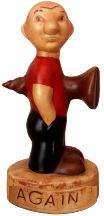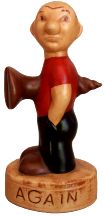 |
 The Virtual Corkscrew Museum's Weekly Newspaper |
 |
 |
 The Virtual Corkscrew Museum's Weekly Newspaper |
 |
|
Sunday, March 25, 2007 |
Brownson's U. S. Patents
On February 18, 1958 Harvey A. Brownson of Baltimore, Maryland was granted U. S. Patent Number 2,823,395 for his Combined Seal Cutter and Closure Removing Device. Brownson wrote "It is one of the objects of this invention to provide a unique cutter-remover device for cutting a seal on a bottle and
for simultaneously removing the bottle cap or cork."
No examples of the above patent have been reported by corkscrew collectors. Brownson had applied for his patent on September 14, 1956. On the same date, he filed for a design patent on a similar device without the folding worm. For this he was granted U. S. Design Patent D180,316 on May 21, 1957; nine months before the utility patent. The title for this one is Combined Seal Cutter and Bottle Cap Remover.
An example of the design patent is shown below. This one is marked U.S.A. PAT. PENDING and has the advertising "Say Seagram's and be Sure / Seagram Distillers Co. New York."
Although an example of Brownson's scissor type device with folding corkscrew has not been found, here are two known "scissor" examples having a folding worm:
In the above photo the top tool is marked NOGENT INOX DEPOSE MADE IN FRANCE. In addition to a folding worm, it has a folding sardine can opener. The tool on the bottom is marked RECOSO SOLINGEN (Germany).
Here is an English tool with cork grip without a folding worm. This one has a bottle cap lifter as well. It is marked HARRISON FISHER AND CO. LTD. SHEFFIELD ENGLAND and on the blade is "Especially made for Carl Forslund in Sheffield, England".
Note: Lynda Whitely of Harrison Fisher writes "The scissors were made for Carl Forslund in America from around the mid 1950's for about 20 years up to around the mid 1970's." The Forslund catalogs offered a variety of home furnishings including magazine stands, pipe holders, smoking stands, clocks, lamps, and glassware. The company was located in Grand Rapids, Michigan.
A number of corkscrews in combination with scissors have been patented in the United States.
A very versatile tool was patented long before Brownson's scissor - corkscrew. On March 4, 1890 U. S. Patent Number 422,670 was granted to Arthur Henry Wallace of Houghton, Michigan for his Shears. His tool includes a button hole cutter, a wire cutter, a needle holder, a nail file, a screw driver, a tack claw, a hammer head, a ruler or scale, and a folding corkscrew.
On January 28, 1896 U. S. Patent No. 553,579 was issued to James Frye of Philadelphia, Pennsylvania for his Combination-Tool. His tool included an adjustable wrench, a tool for replacing gas burners, a tack lifter which could also be used as a kettle or lid lifter, a ruler, a rasp, a hammer, and a corkscrew.
In 1899 Frederick F. Fulks of Buckner, Texas applied for a patent for a knife attached to a scissor handle. He was granted U. S. Patent No. 652,429 on June 26, 1900 for his Combined Shears and Knife. His intended audience was "dressmakers, tailors, and the like". Obviously he added the corkscrew blade for those dressmakers and tailors who wanted to have a little nip while doing their work.
U. S. Patent No. 1,423,127 issued July 18, 1922 to Edward Levy of London, England for Scissors. Levy suggests a number of tools that could be included in the construction of this tool - a knife sharpener, a can opener, a glass cutter, a screwdriver, and a corkscrew.
U. S. Patent Number 1,644,936 issued October 11, 1927 to Paul Mertens of Newark, New Jersey for a Collapsible Corkscrew.
Ivan Randall Churchill Edwards of Georgetown, British Guiana [sic], was granted U. S. Patent No. 2,361,387 on October 31, 1944 for his Scissors. These are manicure scissors for cutting and filing finger nails. Edwards added "Another object is so to construct the ends of the blades as to permit them to be used conveniently as a cork puller."
Several other patents were issued with some reference to wire cutters as shears or scissors.
Remembering Ernst Gallo
On March 6, 2007 Ernest Gallo died at the age of 97. Ernest and his brother Julio founded their winery in 1933 at the end of Prohibition. They used $5,900 and a wine recipe from a public library to start their winery and grew it to be the world's largest winemaking empire.
The firm spent plenty of money on advertising making the Gallo name a household word. The name can be found on many corkscrews and cork pullers.
|
©2007 Don Bull, Editor |